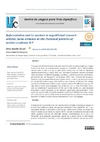Identificador persistente para citar o vincular este elemento:
https://accedacris.ulpgc.es/jspui/handle/10553/70418
| Título: | Reformulation and its markers in unpublished research articles: Some evidence on the rhetorical patterns of written academic ELF | Autores/as: | Murillo Ornat, Silvia | Clasificación UNESCO: | 570107 Lengua y literatura 550510 Filología |
Palabras clave: | English as a Lingua Franca SciELF corpus Similect Reformulation markers Rhetorical patterns, et al. |
Fecha de publicación: | 2019 | Publicación seriada: | LFE. Revista de Lenguas para Fines Específicos | Resumen: | This paper intends to contribute to the description of written academic English as a Lingua
Franca (ELF) from an endonormative perspective (Seidlhofer, 2011). Reformulation
markers (that is, that is to say, in other words, namely and i.e.) fulfil an interactive
metadiscourse function (Hyland, 2007) and have been considered indicators of certain
rhetorical aspects of different languages, specifically, whether expansions, clarifications,
adjustments, etc. are frequent or not (Cuenca, 2003). Here I examine the frequency,
functions, and (non-) parenthetical uses of these markers in the components of a corpus
of unedited ELF research papers (the SciELF corpus, University of Helsinki). The findings
indicate that the frequency of reformulation markers varies in the different L1 groups, with
high rates in the Romance languages. The results also point to other ELF-related trends
such as simplification/ specialization of the use of one marker (i.e.), and discourse
explicitation, closely associated to the functions specification and explanation. Other
outcomes may be related to a global academic context (with different disciplinary areas),
of which ELF forms part (and they would not be ELF-specific). In conclusion, formal written
academic ELF seems to constitute an “endorhetorical” use of the language. En este artículo se pretende contribuir a la descripción del inglés como lengua franca (ILF) en el ámbito académico desde una perspectiva endonormativa (Seidlhofer, 2011). Los marcadores de reformulación (that is, that is to say, in other words, namely y i.e.) tienen una función metadiscursiva interactiva (Hyland, 2007) y han sido considerados indicadores de ciertos aspectos retóricos en diferentes idiomas, concretamente, de si son o no frecuentes las expansiones, aclaraciones, ajustes, etc. (Cuenca, 2003). En este trabajo examino la frecuencia, funciones y usos (no) parentéticos de estos marcadores en los componentes de un corpus de artículos de investigación escritos en ILF y no editados (el corpus SciELF, Universidad de Helsinki). Los resultados indican que la frecuencia de los marcadores de reformulación varía en los diferentes grupos de L1, con niveles altos en las lenguas romances. Los resultados también apuntan a otras tendencias relacionadas con el ILF, tales como la simplificación/ especialización del uso de un marcador (i.e) y la explicitación discursiva, asociada a las funciones de especificación y explicación. Otros resultados pueden relacionarse con un contexto académico global, con diferentes disciplinas científicas, del que el ILF forma parte (y no serían específicos del mismo). Como conclusión, se puede decir que el ILF académico y formal parece constituir un uso “endoretórico” de la lengua. |
URI: | https://accedacris.ulpgc.es/handle/10553/70418 | ISSN: | 2340-8561 | DOI: | 10.20420/rlfe.2019.284 | Fuente: | LFE. Revista de lenguas para fines específicos [eISSN 2340-8561], v. 25 (2), p. 26-43 |
| Colección: | Artículos |
Visitas
52
actualizado el 04-may-2024
Descargas
73
actualizado el 04-may-2024
Google ScholarTM
Verifica
Altmetric
Comparte
Exporta metadatos
Los elementos en ULPGC accedaCRIS están protegidos por derechos de autor con todos los derechos reservados, a menos que se indique lo contrario.
